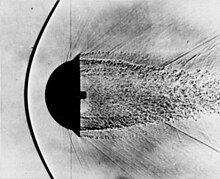This article includes a list of general references, but it lacks sufficient corresponding inline citations. (November 2019) |

A bow shock, also called a detached shock or bowed normal shock, is a curved propagating disturbance wave characterized by an abrupt, nearly discontinuous, change in pressure, temperature, and density. It occurs when a supersonic flow encounters a body, around which the necessary deviation angle of the flow is higher than the maximum achievable deviation angle for an attached oblique shock (see detachment criterion[1]). Then, the oblique shock transforms in a curved detached shock wave. As bow shocks occur for high flow deflection angles, they are often seen forming around blunt bodies, because of the high deflection angle that the body impose to the flow around it.
The thermodynamic transformation across a bow shock is non-isentropic and the shock decreases the flow velocity from supersonic velocity upstream to subsonic velocity downstream.
- ^ Ben-Dor, G. (2007). Shock Wave Reflection Phenomena. Shock Wave and High Pressure Phenomena. Bibcode:2007swrp.book.....B. doi:10.1007/978-3-540-71382-1. ISBN 978-3-540-71381-4.